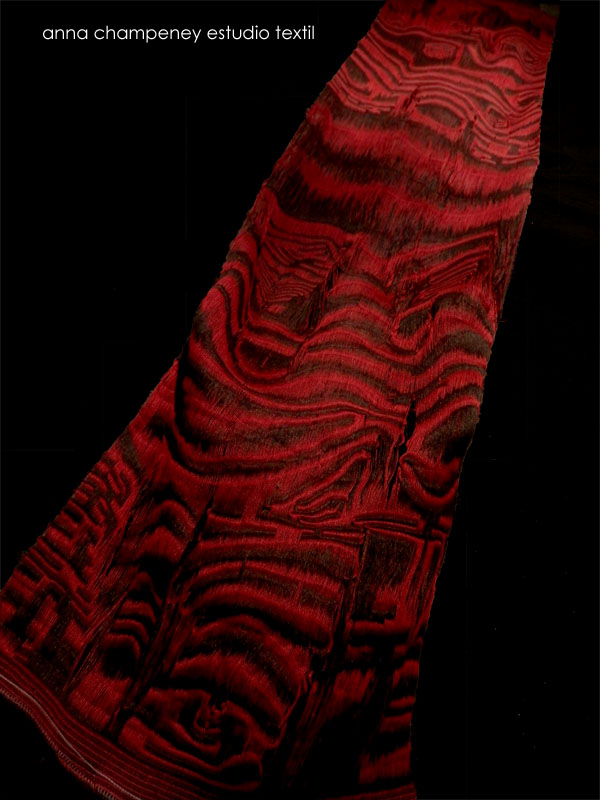
 This is no ordinary hand-woven linen cushion for every bucle in this loop-pile fabric has been formed completely by hand – by the weaver´s fingers. The technique of felpa gallega, as it is called, is over 1000 years old and in rural Galicia, in mountainous northwest Spain, this macro-pile fabric is still being made in exactly the same way, on wooden hand-looms, by a new generation of Galician weavers. There is no industrial alternative to an authentic Galician felpa textile – it remains a totally hand-made technique, which is why it is becoming so rare in Spain.
This is no ordinary hand-woven linen cushion for every bucle in this loop-pile fabric has been formed completely by hand – by the weaver´s fingers. The technique of felpa gallega, as it is called, is over 1000 years old and in rural Galicia, in mountainous northwest Spain, this macro-pile fabric is still being made in exactly the same way, on wooden hand-looms, by a new generation of Galician weavers. There is no industrial alternative to an authentic Galician felpa textile – it remains a totally hand-made technique, which is why it is becoming so rare in Spain.
How long does it take to make a felpa cushion? An authentic felpa cushion such as this one takes approximately 15 hours to make in total, about 10 of which are spent in forming each of the thousands of bucles by hand. The time involved in making felpa textiles explains why the technique has such a high value and why it is so rare. Modern felpa textiles are not sold via shops, only directly from the weaver´s studio, ensuring best value both for the maker and for the customer.
Felpa was traditionally used to make heavy, brightly-coloured and warm bed-covers, colourful “jewels” in the austere stone farmhouses of the Spanish mountain villages and hamlets. Today Anna Champeney Estudio Textil employs the technique to make felpa cushions in both traditional and bold, colourful and contemporary designs. Each cushion, which uses high quality linen and authentic, locally-sourced wool, is made in exactly the same way as centuries ago, with each bucle pulled out of the body of the cloth, by hand.
One-off pieces are sold on the internet and directly from the workshop (where you can also spend your holidays in the studio´s holiday cottage, Casa dos Artesans), located in the idyllic Ribeira Sacra, part of north Spain and about 2 hours from the famous pilgrimage city, Santiago de Compostela. The Anna Champeney Textile Studio can also make one-off piecs similar to the one shown, by commission and offers holiday tuition, both for beginners and those with weaving experience. Anna Champeney is able to offer illustrated talks on felpa gallega, based on years of ethnographic research into the technique.
This cushion is available for sale and is a one-off, unrepeatable design
The cushion has a hand-woven natural linen backing and is fitted with an invisible zip and is supplied with the filler. Hand-wash, without soaking.
Inquire about felpa textiles made to order
 Felpa Weaving Tuition in Spain
Felpa Weaving Tuition in Spain
 The initial inspiration for this hand-woven linen wallpiece was the technique of Ikat dyeing and weaving. Woodgrain and knots in cut wood, tally marks and scrolls together with newsprint and other communication systems and watermarks have all fed in to the creative process of creating an ongoing series of pieces.
The initial inspiration for this hand-woven linen wallpiece was the technique of Ikat dyeing and weaving. Woodgrain and knots in cut wood, tally marks and scrolls together with newsprint and other communication systems and watermarks have all fed in to the creative process of creating an ongoing series of pieces.


 This is no ordinary hand-woven linen cushion for every bucle in this loop-pile fabric has been formed completely by hand – by the weaver´s fingers. The technique of felpa gallega, as it is called, is over 1000 years old and in rural Galicia, in mountainous northwest Spain, this macro-pile fabric is still being made in exactly the same way, on wooden hand-looms, by a new generation of Galician weavers. There is no industrial alternative to an authentic Galician felpa textile – it remains a totally hand-made technique, which is why it is becoming so rare in Spain.
This is no ordinary hand-woven linen cushion for every bucle in this loop-pile fabric has been formed completely by hand – by the weaver´s fingers. The technique of felpa gallega, as it is called, is over 1000 years old and in rural Galicia, in mountainous northwest Spain, this macro-pile fabric is still being made in exactly the same way, on wooden hand-looms, by a new generation of Galician weavers. There is no industrial alternative to an authentic Galician felpa textile – it remains a totally hand-made technique, which is why it is becoming so rare in Spain.  Felpa Weaving Tuition in Spain
Felpa Weaving Tuition in Spain


Customised cushions – hand-woven with natural dyes (Design ref. “Spots & Squares”)
As you can see the “Spots and Squares” cushion design woven at the Anna Champeney Textile Studio is a simple but modern interpretation of a traditional weaving pattern and uses 4 different colours. The natural-dyed wools contrast beautifully with the crisp white or grey linen background. Clients who visit the studio in northwest Spain can choose the individual balls of hand-dyed yarns for their commissions, but those who order by internet can still select a general range of colours – “earth colours” or “purples and reds” “all pastels” or “black through to light grey” and we will do our best to interpret these choices.
Today, 19 March 2010, we are weaving a cushion in a range of indigo blues, from dark through to a pale greeny-pastel blue. Next week we will start on weaving other versions in different colourways….